Wine drinkers with ambition know it: one vintage is not like another. 2000 and 2010, for example, were wonderful in Bordeaux, while 2013 is to be avoided. Every wine guide therefore contains a list of good and inferior vintages for each region. But what if winemakers threw this tradition overboard?
A year on the wine label tells you in which year the grapes were harvested. The weather in that year has an influence on the grapes, and the quality of the grapes affects the taste and the storage capacity of the wine. It is obvious that the vintage is traditionally important. It is not compulsory everywhere to put the year on the label, but it is in Canada and the United States, for example, as it is in Alsace, France. At least 95% of the grapes must be from the year shown on the label.
For many people, wines without a vintage are table wines. However, if you like champagne, you will be drinking wines without a vintage but with a standing. Joseph Krug caused a revolution in the champagne world in 1843. He was convinced that the impact of the weather on the champagne had to be filtered out by blending. Therefore he made a collection of reserve wines, which enabled him to make excellent champagne every year with wines that were 1 to 25 years old. Nowadays, almost all champagne houses blend vintages.
For other wines, this rarely happens, but things are starting to change. Wildekrans Wine Estate on South Africa’s Botrivier not only blends four grapes that are rarely used together in Europe in its Deep Purple: Shiraz, Cabernet Franc, Merlot and Pinot Noir, each of them has a different vintage. A dark, full-fruited and yet spicy topper, with the cool undertone typical of wine from a fresh climate. Exclusively at Paradisi.


